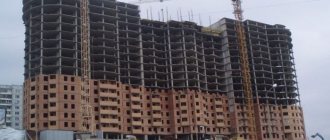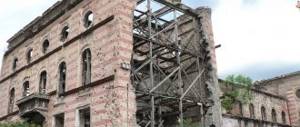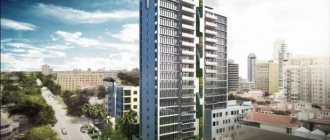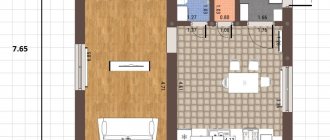Legacy of a bright future
Our country will experience the legacy of a bright future for a long time to come. The most unforgettable impressions of the Soviet era were left by special projects of multi-story buildings - Stalin and Khrushchev. If Stalin buildings were only for the elite of society - engineers of large enterprises, directors and other persons of special importance at the lowest level, then Khrushchev buildings were built for everyone - workers, employees and their numerous families.
But a little later the situation became even more complicated - Brezhnevka appeared. In order to somehow understand this diversity of Sovdepov’s heritage, we will try to find out how these projects differed from each other.
Main types of apartments
Before we find out how “Brezhnevka” differs from “Khrushchevka” and “Stalinka”, let’s look at all the main types of apartments in Russia:
- Stalin's apartments. Living quarters in houses built during the reign of I.V. Stalin - in 1930-1940.
- "Khrushchevka". Apartments in brick or panel houses, massively built in 1950-1960.
- "Brezhnevki". Typical apartments in multi-storey buildings built in 1960-1980.
- "Improvements." Apartments with improved layout in buildings from the 1980s. They were distinguished by an increased area, separate bathroom, spacious kitchen and balconies (loggias); The house had a garbage chute and an elevator.
- Modern monolithic houses. Spacious, open-plan apartments with varying ceiling heights and strong and durable walls.
- Apartments in modern panel and block houses.
This is interesting: Searching for real estate by cadastral number of Rosreestr: how to check information about the property and find the owner?
To understand how “Khrushchevka” differs from “Brezhnevka” or “Stalinka”, let’s briefly describe each group of apartments.
Khrushchev and Brezhnevka. What is the difference?
The difference is small. But it is there. It is clear that no one has improved architectural projects, design of utility networks and a banal area overnight. But there was still a difference.
- Naturally, the construction time for these two types of high-rise buildings is different. Although Khrushchev buildings continued to be built even until 1985.
- Layout. Brezhnevkas are absolutely unpredictable in terms of apartment layout. From the outside, the houses may look exactly the same, but what is planned inside is amazing. About fifty standard projects alone were envisaged. In Khrushchev everything is stable - one project and a minimum of square footage.
- Number of storeys. Brezhnevki are higher. Literally. From five to infinity. In the 70s, the problem with housing did not disappear; a lot of housing was needed, but there were no longer enough places in the cities. That's why nine-story buildings appeared. Real chic - with an elevator that almost never works, with a garbage chute, the feasibility of which can also be discussed for a long time, and with its own characteristic layout.
- Everything is separate. If in Khrushchevkas they tried to cram everything into one square meter and combine everything with everything, then in Brezhnevkas there was such a luxury as a separate bathroom, a minimum of walk-through rooms. The living conditions of citizens were improving!
- Ceilings. It's a small thing, but nice. In Khrushchev the ceiling was no higher than 2.2 meters, while Brezhnev made one feel the freedom of two and a half meters. Some are luckier - there are projects with ceilings of 2.7 meters.
- Additional premises. Brezhnevkas now have niches for refrigerators and pantries. This simply could not happen in Khrushchev-era buildings due to the tiny area. What kind of refrigerator if the kitchen is 5 square meters?
- A vestige of the thirties - a window from the bathroom into the kitchen, in Brezhnevkas, began to slowly disappear as unnecessary. No one knew then that in the 90s they would turn off the lights again.
Perhaps these are not all the differences between these two types of budget housing, but still, these differences affect the cost of such apartments. Check out the cost of designing and building houses in 2020.
"Stalin": space and high ceilings
Stalin's houses are, in a way, also beautiful creations in the spirit of neoclassicism, 2-5 floors high. The main material for them was brick (white, red), which was covered with plaster at the finishing stage. An interesting point: in the pre-war “Stalin” buildings, only the floors of the first floor and the ceiling of the last floor were concrete, and the interior floors were wooden. In post-war houses, all floors were made of reinforced concrete.
“Stalin” apartments are mainly multi-room apartments (3-4 rooms); one- and two-room apartments are very rare among them. The premises are distinguished by good square footage, spacious kitchens and hallways, rooms isolated from each other, and in some cases balconies. But most of all, “Stalin” buildings are valued for their ceiling height - 2.8-3.2 m.
Clear benefits
Like everything else, the apartments listed above have their pros and cons. To have a complete understanding of the differences between a “Khrushchev” apartment and a “Brezhnevka” and “Stalin” apartment, let’s consider all their advantages:
- “Stalin” apartments: good location (in most cities such apartments are located in the center), spacious layout, high ceilings, excellent heat and sound insulation, large windows, isolated rooms, warm and dry brick houses, smooth walls and ceilings.
- “Khrushchevka”: affordability, location, if not in the center, then in an area with already fairly developed infrastructure.
- “Brezhnevki”: isolated rooms, good location in the city, the presence of an elevator and garbage chute, convenient layout, relative “youth” of the building, panel houses have perfectly smooth walls and ceilings.
"Khrushchevka": small, but its own
Continuing to talk about how “Khrushchevka” differs from “Brezhnevka”, we will analyze the characteristics of the premises built during the reign of Stalin’s successor. The motto of the construction of residential buildings, which started in 1955 according to the decree “On the development of housing construction in the Soviet Union,” was the slogan: “Each family has a small, but its own home!”
“Khrushchevka” are typical brick or panel houses of 3-5 floors, with low ceilings (2.5 m), without access amenities (elevator and toilet). Such buildings had no architectural value - they were built only to eliminate the housing shortage. One- and two-room apartments were characterized by poor sound insulation, the presence of adjacent non-insulated rooms, and a small combined bathroom.
"Brezhnevki": improved high-rise buildings
The photo eloquently shows how “Khrushchevka” differs from “Brezhnevka”: the houses of the Leonid Ilyich era are already high-rise buildings with 5-14 floors. All of them were built, changed, modernized according to one document - the Unified Catalog of Construction Parts. “Brezhnevki” became in many ways the prototypes of modern comfortable new buildings. The layout of such apartments has significantly improved, garbage chutes and elevators have appeared in the entrances, and staircases and landings have become more spacious.
Inside the Brezhnev-era apartment you can already see a separate bathroom and toilet, waterproofing in the bathrooms, and a large area of the rooms. However, the same cramped kitchen, corridor and bathrooms remained. That's all, actually. Now you know the difference between “Khrushchev” and “Brezhnevka” in layout.
House type Khrushchev
Khrushchev buildings are the first type of mass development in the period from 1956 to 1985. Initially, this type of house was built from brick, but later reinforced concrete blocks began to be used. In terms of external parameters, the facades of the houses differ slightly - they have from 4 to 5 floors.
Apartments in brick buildings have an area of up to 22 square meters. In rare cases, kitchens are more than 4.5 square meters, and rooms are from 6 to 9 square meters. The bathroom in such apartments is combined.
Khrushchevka
Differing in number of floors, design features and convenience, the “Stalinka” buildings gave way to the so-called “Khrushchevka” buildings by the 60s. These houses began to be built in 1959 during the reign of Nikita Khrushchev. Basically, “Khrushchev” buildings are five-story panel buildings with a standard layout.
But there are also brick “Khrushchev” apartments - with small platforms, narrow staircases and kitchenettes 5 meters long. It is necessary to take into account that one-room “Khrushchev” apartments often do not have balconies, and the rooms in this apartment certainly cannot be called spacious. The space of the apartment is also reduced by the low ceiling, not exceeding 2.5 meters. In some typical “Khrushchev” buildings the ceiling may be even lower. But the price of housing is more modest than any other, and a good design project will help turn a small space into an acceptable living space.
Old fund
These are buildings that have survived from the end of the 19th century and were erected before the 1940s. Their walls are usually brick or wood, and the ceilings and internal structures are also wooden. But modernization could also be carried out (replacing the floors with metal ones).
Main advantages: location close to the city center, thick external walls and original layouts: such houses usually have many small rooms, long corridors, and often the kitchen is a walk-through and has no windows. Elite houses of this type have luxurious entrances with spiral staircases.
There are many disadvantages, and most of them are related to the age of the buildings: worn out communications, the need for frequent and complex repairs. Often in such houses it is troublesome or even impossible to obtain permission for redevelopment. Old houses need to be chosen very carefully: carefully inspect the house from the basement to the roof, read the documentation, compare the image of the apartment on the plan with reality. It is good if the house has undergone renovation and a recent inspection. The “old fund” may be unreasonably expensive due to its location.
Stalin's houses are brick or ceramic block buildings built from the mid-30s to early 60s. There are a lot of options for “Stalin” guns - they can’t be called typical. The houses that were built for party workers look very presentable in appearance, have wide staircases, comfortable layouts with isolated large rooms and, most importantly, a spacious kitchen of 7-14 m². Their noise and heat insulation quality is often superior to new buildings.
Stalin buildings of a lower class, for workers, were often used as communal apartments: there are long corridors, small rooms, kitchens from 4.5 m².
Common advantages of all Stalin buildings: structural strength, high ceilings from 2.9 m, good layout. The other side of the coin: worn-out communications are the scourge of all old houses. However, if reconstructions were carried out with the replacement of communications, the house will last for a long time, and buying an apartment in it will be a good investment.
This is the first type of housing of mass construction from 1956 to 1985. “Even though it’s small, it’s our own”—this home became the first nest for many who were tired of living in public view in a communal apartment. At first, the Khrushchev buildings were brick, and later - panel ones. They are similar in appearance and have 5 floors (less often 4).
Apartments in brick Khrushchev buildings have an area of 22 m², a kitchen rarely larger than 4.5 m² and a combined bathroom. Rooms are 6–9 m², there are even rooms of 4 m² without windows. These undistinguished dimensions, low ceilings up to 2.6 meters and poor sound insulation currently result in the only advantage - low cost. These houses were designed for 25 years of service, but are still in use today, so even with a very limited budget, it is better to save up to buy something more reliable. At a minimum, it is worth carefully inspecting the house both inside and out, assessing its strength and quality of communications.
But even with all these shortcomings, brick Khrushchev buildings are better than panel ones. With similar areas, apartments of this type have huge heat losses due to the quality of the walls. It makes sense to buy such apartments only if they have been insulated.
Brezhnevki - panel houses made of concrete and expanded clay, 1960–1990. This is an improved version of the Khrushchev-era panel buildings with an increased number of floors (9 or 16 floors), although there are also five-story Brezhnevkas, which are very similar in appearance to the Khrushchev-era buildings. They began to install elevators and garbage chutes in these buildings, and increased the area of the apartments and the height of the ceilings to 2.70 m. The kitchen is 6–8 m², the bathroom is separate. The walls of Brezhnevka buildings are of better quality, but there are variations of this type of houses with very small apartments - gostinkas: the walls of such houses are no different from the panel Khrushchev houses.
This is interesting: Refund of money for goods to a Sberbank card: timing and procedure for transferring funds
Brezhnevkas are better than Khrushchev panel buildings and are inexpensive, like all old panel houses, but it is still better to give preference to brick buildings or turn your attention to more modern housing. By the way, we will talk about it in the second part of this article.
Stalinka
This is the name given to houses that were built during the reign of Stalin. In the period from the late 30s to the mid-50s, two-story buildings were built mainly from non-combustible materials.
Communal amenities included:
- water pipes;
- sewerage;
- heating
Layout
A distinctive feature of these houses is their spaciousness. The area ranged from 50 to 100 sq. m. The apartment could consist of 3, 4 or even more rooms. There was no single architectural plan. The types of houses differed significantly. The rooms could be adjacent or separate. The apartments were equipped with bathrooms, sometimes even two. One-room Stalin buildings are less common, but they were built, and their square footage ranged from 32 to 50 sq. m.
In the 50s they began to build Stalinist buildings, which certainly included:
- living rooms;
- kitchen;
- front;
- bath or shower;
- restroom;
- pantry;
- built-in wardrobes.
A distinctive feature is the high ceilings, which reached 3 or 3.2 m. Buildings that were not connected to networks were designed with the possibility of further implementation of utility systems.
After the change of power, a decision was made to combat architectural excesses. Houses began to be built without external decoration. Not a trace remains of the former monumentality and decor. And soon the country switched to mass industrial construction. The decision was made to build smaller houses. This is how Khrushchevkas appeared in the country.
Important Disadvantages
To fully understand how “Khrushchev” differs from “Brezhnev” and “Stalin”, let’s get acquainted with the repulsive characteristics of such apartments:
- “Stalin”: the first floors are guaranteed to be devoid of loggias and balconies (not counting the initiative of the previous owners), unreliable ceilings, the high cost of the apartment itself and repairs in it, noticeable wear and tear of both the building itself and its communications, lack of modern infrastructure - an elevator, a garbage chute, underground parking, etc.
- “Khrushchev”: high degree of wear, the possibility of cracks and fungus appearing on the walls, low ceilings (2.5 m), noticeably weak sound insulation, poor thermal insulation (hot in summer and cold in winter), adjacent or walk-through rooms, inconvenient narrow corridors and staircases cages, small kitchens and rooms, combined bathroom, the recommended lifespan of the building is 25 years.
- “Brezhnevkas”: small kitchens, walls that require frequent repairs (leaks in the external walls, split seams in the internal ones), there is no elevator in 5-story buildings, it is cold in winter due to the radiators built into the wall, the floor becomes noticeably uneven due to subsidence of concrete .
Thus, “Stalin” models are the most expensive, but also less in demand. “Khrushchev” and “Brezhnevka” buildings find buyers faster, attracting them with their availability. At the same time, all types of secondary housing have a large list of both advantages and disadvantages.
Brezhnev's layout: the history of Brezhnev's apartments
“Khrushchevkas” were very well suited for the quick and cheap resettlement of USSR citizens into separate apartments, but time passed and more modern solutions were required.
As a result, a whole series of houses appeared, popularly called “Brezhnevkas”.
This name comes from the name of Secretary General L.I. Brezhnev, during whose time large-scale construction of this house layout took place, although some were also built under Khrushchev and were called “early Brezhnevkas”.
In general, the period of construction of houses of this layout took from 1964 to the beginning of the 1980s, although this applies to Moscow, in the regions the construction of some layouts related to “Brezhnevka” continues to this day.
The peak of construction of houses with the Brezhnevka layout occurred in the 70s and 80s. last century, they were built from panels, bricks and rarely from blocks.
Location of houses in Khabarovsk with the Brezhnevka layout
Houses with the Brezhnevka apartment layout are located in the city center on the street. Vladivostokskaya, are present along city ponds, in the Southern and Northern microdistricts. As a rule, buildings are adjacent to each other, creating microdistricts (applies to five-story buildings); there are also isolated detached houses (applies to multi-story buildings).
Comparison
To understand the difference between Khrushchev and Stalin, let’s find out what the features of each type of house and the apartments located in them are.
Khrushchevka
Such houses were once built en masse in order to alleviate the situation with the housing shortage in the country. The goal was to spend the minimum amount of money. Among other things, it was decided not to install elevators in the houses. Therefore, the number of floors in Khrushchev is limited to five.
Residential buildings of this type were built quickly, since most often they had a panel construction. However, there are also brick buildings of this type. All Khrushchev buildings are united by a strict style. Their facades are made without any decorative design. Brick houses, as a rule, are not plastered.
The area of the Khrushchev apartments is small. There are usually two or one rooms in an apartment, less often three. In the kitchen and hallway you can't do much. Most projects have a combined bathroom. Mandatory amenities: central heating, water supply (usually only cold), sewerage. Khrushchev apartments are usually purchased for the first time by young families.
Stalinka
Such objects were intended to accommodate people of different statuses, so their exterior, interior design and amenities may be different.
Monumental brick buildings with ceremonial architecture, elevators and spacious entrances were erected for the elite of society: party leaders, valuable scientists, outstanding cultural workers. Apartments in such houses are as comfortable as possible, with a convenient layout and high (often above 3 m) ceilings. The rooms are wide and bright. The kitchen and hallway are also spacious. The bathroom is separate from the toilet.
The buildings were more modest, without much decoration, and were intended for ordinary residents. But, despite the lack of pomp, apartments in such buildings are also distinguished by good square footage and amenities.
There are also low-level Stalin buildings, built from brick or cinder blocks. Many of them were originally dormitories for workers. The area of apartments in such buildings is much smaller, there is often no bathroom, and several families may have one bathroom. By now, these Stalin buildings have become noticeably dilapidated, but some of them have undergone major renovations and now have amenities.
What is the difference between Khrushchev and Stalin in terms of cost? It should be noted here that Khrushchev is cheaper on average. High-order Stalins, despite their age, remain valuable, especially if they undergo good repairs.










